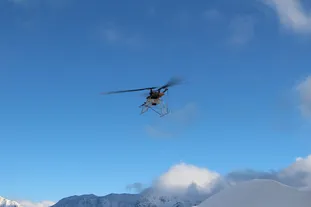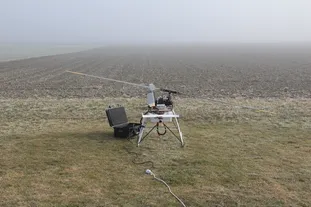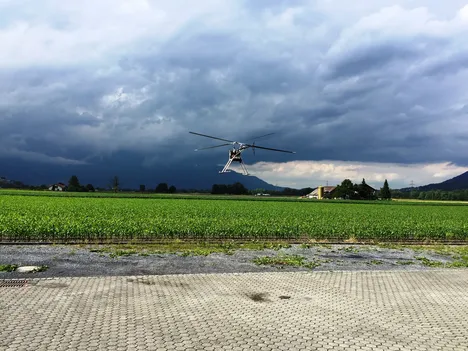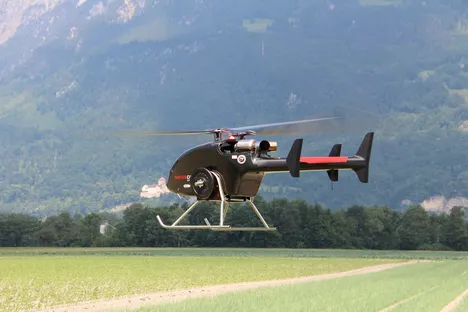Autonomous Rotorcraft for Extreme Altitudes (AREA) in Synchropter (Flettner) Konfiguration
Kurze Geschichte der AERA-Drohne
Das zivile Forschungsprojekt „Autonomous Rotorcraft for Extreme Altitudes (AREA)”, das in Zusammenarbeit zwischen der TUM, dem DLR und Bauhaus Luftfahrt durchgeführt wurde, hatte zum Ziel, ein leichtes Drehflügler-UAV für Anwendungen in großen Höhen von bis zu 9000 m zu entwickeln, wie z. B. Such- und Rettungsaktionen sowie verschiedene Arten der Umweltüberwachung. Bisher gab es solche Drehflügler-UAVs noch nicht. Daher gibt es auch keine Erfahrungen mit der Konstruktion und dem Betrieb von Drehflügler-UAVs in solchen Umgebungen.
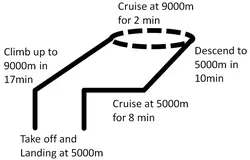
Die Herausforderung bei der Entwicklung eines Drehflügler-UAV mit (in 2015) verfügbaren Batterien und einem maximalen Startgewicht von ca. 40 kg besteht darin, dass das gesamte System über das gesamte Missionsprofil hinweg äußerst effizient sein muss. In Bezug auf den Rotor bedeutet dies, dass niedrige Werte für die Blattbelastung auf Meereshöhe erforderlich sind, um die Leistung zu reduzieren und das Einsetzen des Strömungsabrisses in größeren Höhen zu verzögern. Im Vergleich zu einem herkömmlichen Hubschrauber mit Haupt- und Heckrotor und der gleichen Blattbelastung benötigen Doppelrotorkonfigurationen im Schwebeflug oder bei niedrigen Geschwindigkeiten in der Regel weniger Leistung für einen bestimmten Schub. Daher wurde beschlossen, einen Hubschrauber vom Typ Flettner mit kämmenden Rotoren zu konstruieren. Zusätzlich zu den extremen Anforderungen für das UAV wurden an der TUM Rotorblätter entworfen, getestet und gebaut.
Die Ergebnisse der Entwurfs-, Konstruktions- und Flugtests sind in der Dissertation von Dr. Aaron Barth dokumentiert, die über MediaTUM abgerufen werden kann
The project was supported by a MunichAerospace scholarship.
Stichworte: High Altitude Helicopter Drone, Hubschrauberdrohne, Flettner, Synchropter.
NEWS
The AREA drone is going to be modified with a hydrogen propulsion system:
_________________________________________________________________________________________
AREA Flight Test at 2830m MSL (41 different flights with different rotor speeds and gross weights were made on 2018-11-08)
Flight Testing of the TUM/DLR Rotorcraft Prototype for High Altitudes with Intermeshing Rotors.
AREA Flight Test Forward Flight
AREA Flight Test Attitude Controller Doublets and Hover
AREA Flight Test with 20kg payload and rate controller
Flight Tests for Model Validation with automatic Doublet and Step Inputs, 900ft/min vertical climb demonstration
AREA first flight
Succesfull first hover test of a pre prototype with off the shelf parts
On June 19 2015, the first hover flight tests with a pre prototype (with mosty off the shelf parts) were performed. The all-electric system was operated at design configuation. But it emerged that the off-the-shelf parts do not satisfy our requirements. Thanks a lot again to SwissDronesAG for conducting the flights!
Succesfull first hover fligth test of new AREA rotorblades
Combined tensile & bending test for the AREA rotor blade
On March 23 2015 a combined tensile and bending test for the self developed AREA rotor blades was made. Great thanks to Prof. Baier and Mr. Krämer from the Institute of Leightweight Structures for their great support.The requirements for limit and ultimate load are by far exceeded once again.
Production of the first rotor blade for the AREA-Project
A first rotor blade prototype has been demolded on January 20th 2015. We would like to thank the Institute for Carbon Composites for the support during the manufacturing of the rotor blade.
AREA first flight with off-the-shelf blades and gearbox
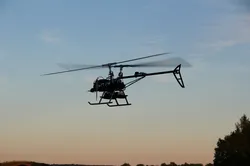
A first flight was conducted on July 1st 2014. The flight was intended to perform system and control checks. The prototype hovered for 2x12min in an altitude of 10m above ground.
Projektpartner
Deutsches Zentrum für Luft- und Raumfahrt (DLR)
Robotics and Mechatronics Center, RMC
Institute of Robotics and Mechatronics
www.dlr.de/rm


